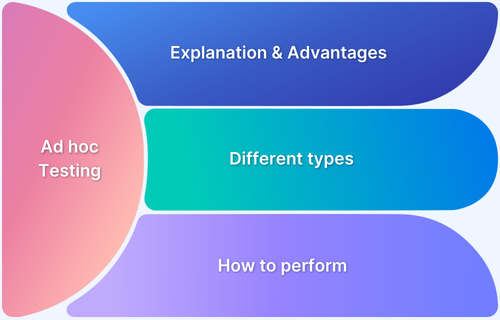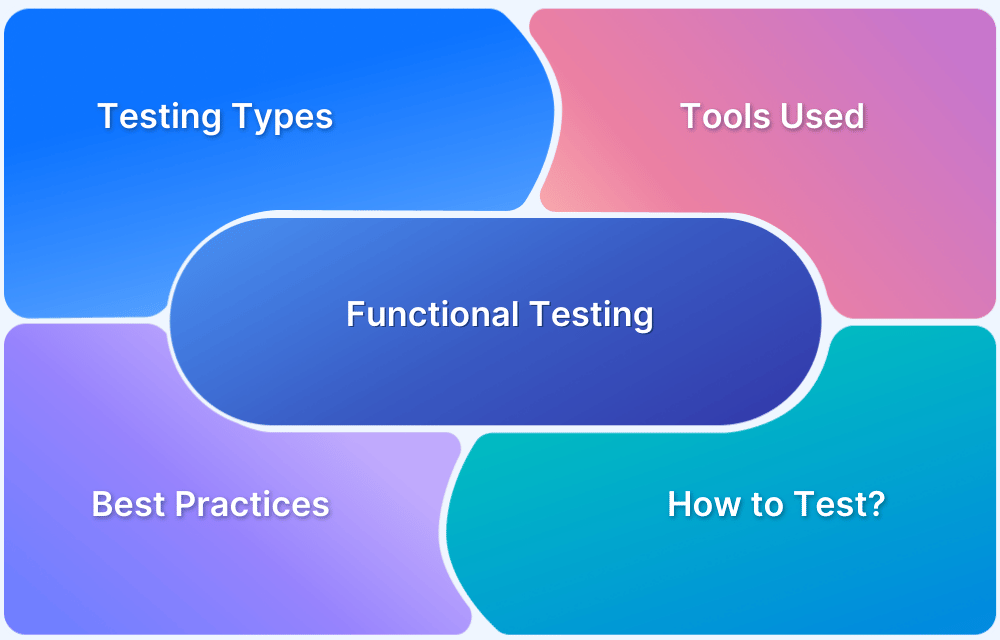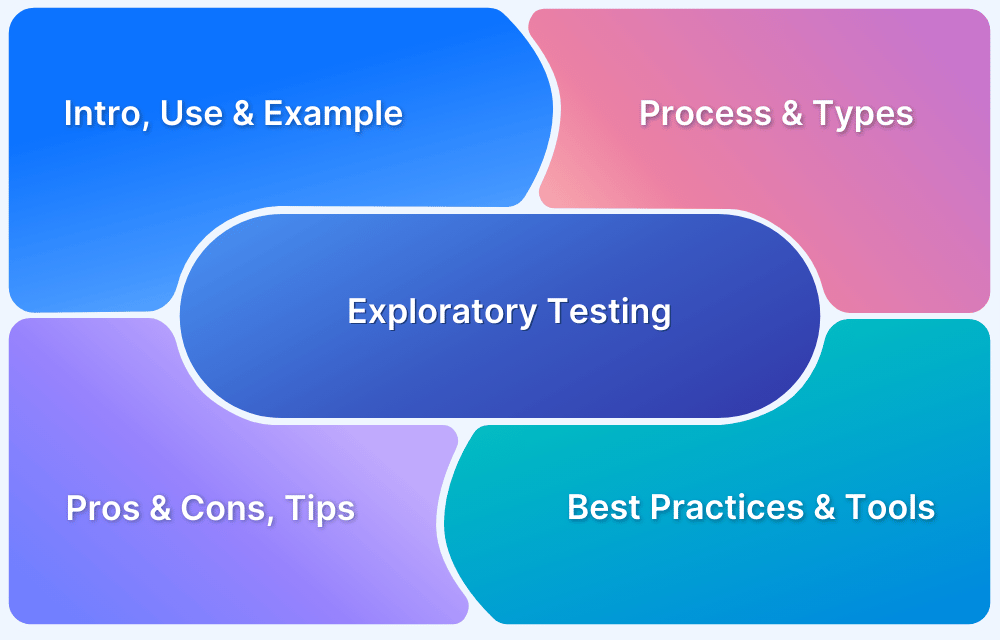Ad hoc testing is a software testing technique performed without any specific test plan or predefined set of steps. Instead, testers use their intuition, experience, and creativity to identify defects and issues that more formal testing methods may not find.
This guide will explore the various aspects of ad hoc testing and provide tips on effectively performing it.
What is Ad hoc Testing
Ad hoc testing is an informal, unstructured testing method where testers explore an application without a predefined test plan. It relies on intuition and experience to uncover defects that structured testing might miss.
This flexible approach allows testers to adapt to changing requirements and identify critical issues quickly. However, its lack of documentation and consistency can lead to overlooked defects.
To enhance its effectiveness, testers should deeply understand the application and complement it with structured testing for comprehensive coverage.
Must Read: Exploratory Testing: A Detailed Guide
Features of Adhoc Testing
Ad hoc testing is a flexible and intuitive approach that helps uncover hidden defects by deviating from structured testing methods. Here are its key features:
- Performed spontaneously without a predefined structure.
- Does not rely on documentation, test cases, or test designs.
- Conducted after formal testing to identify overlooked defects.
- Follows an exploratory and unstructured approach.
- Requires less time compared to other testing methods.
- Effective in detecting unexpected bugs and inconsistencies not covered in planned test cases.
Learn More: Adhoc Testing vs Exploratory Testing
Importance of Adhoc Testing
Ad hoc testing plays a crucial role in software quality assurance by identifying defects that structured testing may overlook. Here’s why it is important:
- Detects unexpected bugs and errors.
- Helps testers explore software functionality in-depth.
- Provides quick insights and user feedback.
- Enhances test coverage beyond predefined cases.
- Offers flexibility and efficiency in dynamic testing environments.
Note: Ad hoc testing is valuable but should complement structured methods for thorough evaluation.
When to use ad hoc testing?
Testing teams have multiple things to test within limited timeframes. As testers focus on performing formal processes and executing numerous testing tasks, the chances of ad hoc testing are small to make it into the testing cycle.
It is executed when there isn’t time to finish extensive testing, which consists of creating test cases, test requirements documents, and test case designs.
Here are different situations where you can rely on ad hoc testing:
- Ad hoc testing can be used as a part of user acceptance testing, where end-users are encouraged to test the software in their environments and provide feedback.
- You can also use it as a part of exploratory testing, where testers explore the software in an unstructured manner to uncover defects and issues.
- Ad hoc testing can quickly validate the functionality and identify any issues when a new or unfamiliar feature is introduced.
- Although the best time to execute ad hoc is after the formal testing, you can use it early in the development cycle, before a formal test plan has been created, to identify defects and issues quickly.
- Also, when there is limited time available for testing, ad hoc can be a vital approach to identify faults quickly.
- You can also use the approach to test specific areas of the software that are known to be error-prone or have a history of defects.
When not to use adhoc testing
While ad hoc testing is effective, there are situations where it may not be suitable:
- During Beta Testing: Clients assess the software for feedback and feature suggestions, making structured testing more appropriate.
- On Defective Test Cases: Issues should be documented and resolved before retesting to ensure accuracy.
- For Simple UI Changes: Basic positive and negative testing is usually sufficient to detect flaws.
Also Read: Difference between Alpha and Beta Testing
Types of Ad hoc Tests
Ad hoc testing includes various approaches to uncover defects through unstructured and intuitive testing. Key types include:
- Exploratory Testing: Testers use domain knowledge and intuition to design and execute tests, ideal for complex or rapidly changing software.
- Functional Testing: Focuses on software functionality without predefined test plans, allowing testers to identify unexpected defects.
- Performance Testing: Simulates real-world conditions to detect performance bottlenecks.
- Security Testing: Identifies potential vulnerabilities by simulating attack scenarios.
- Usability Testing: Evaluates user interface and experience, uncovering navigation and usability issues.
- Buddy Testing: A developer and tester collaborate, allowing early defect detection and quick fixes.
- Pair Testing: Two testers work together—one executes tests while the other records findings, enhancing efficiency.
- Monkey Testing: Random inputs test system behavior without predefined test cases, exposing unexpected failures.
How to Conduct Ad hoc Testing
To conduct ad hoc testing, testers explore the software without predefined test cases, relying on intuition and experience to uncover defects. They interact with different functionalities, observe system behavior, and document any unexpected issues.
Below are the prerequisites to prepare for ad hoc testing and detailed steps on how to conduct it.
Also Read: How to write a good Test Summary Report?
Preparing for Ad Hoc Testing
Here are the pre-requisites to perform Adhoc testing:
- Define Test Objectives: Identify key areas and risks, set measurable goals, and outline expected outcomes to ensure focused testing.
- Select the Test Team: Choose experienced testers with diverse skills to enhance defect detection and provide different perspectives.
- Set Up Test Environment and Data: Simulate real-world conditions with the necessary hardware, software, and secure test data for accurate results.
- Outline a Flexible Test Plan: Define scope, key testing areas, and methods while keeping room for adaptability to maximize effectiveness.
Also Read: Defect Tracking in Software Testing
Steps to conduct Ad hoc Testing
Below are the key steps to conduct Adhoc Testing:
- Determine which areas of the software need to be tested based on potential risks, critical functionalities, and past defect trends.
- Gain a basic understanding of how the software works to effectively explore and identify possible defects.
- Choose the appropriate method, such as exploratory, usability, functional, performance, or security testing, based on the objectives.
- Interact with the application in an unstructured manner, trying different inputs, navigation paths, and edge cases to uncover defects.
- Monitor responses, unexpected crashes, UI glitches, performance slowdowns, or incorrect outputs while testing.
- Record all observations, including defects, unusual behaviors, and areas for improvement, along with relevant screenshots and logs.
- Log identified defects-tracking system issues, providing detailed descriptions, reproduction steps, and severity levels.
- Collaborate with the development team to discuss findings, clarify defects, and provide supporting details for quicker resolution.
- Verify whether the reported defects have been resolved correctly and ensure no new issues have been introduced.
- Identify patterns in defects, assess software stability, and determine if further structured testing is needed.
- Suggest code quality, UI, performance, or security improvements based on testing insights to enhance the overall software.
- If necessary, conduct additional rounds of ad hoc testing to explore newly introduced features or areas impacted by defect fixes.
Read More: What is Test Evaluation Report
Tools for Ad hoc Testing
Here are five useful tools for ad hoc testing:
- JIRA: A widely used defect-tracking and project management tool that helps testers log, track, and manage issues found during ad hoc testing.
- Selenium: An open-source automation tool that can assist in quickly executing exploratory UI tests without predefined test scripts.
- Bugzilla: An open-source bug-tracking tool that helps log, prioritize, and resolve defects discovered during ad hoc testing.
- Cucumber: A behavior-driven development (BDD) tool that allows testers to write test scenarios in a human-readable format, aiding in exploratory testing.
- Postman: A powerful tool for ad hoc API testing, enabling testers to send requests, analyze responses, and identify potential issues quickly.
Test on Real Devices with BrowserStack
For effective ad hoc testing, testers and developers can leverage BrowserStack to ensure compatibility across real browsers and devices. This allows quick issue identification under real-world conditions without complex setups.
Key Benefits:
- Real Device Testing: Test on actual devices instead of emulators or simulators for accurate results.
- Seamless Exploratory Testing: Access a real device cloud to mimic real-life user conditions.
- Automation Integration: Streamline formal testing with BrowserStack Automate, Live, App Live, and App Automate to save time and effort.
- Cross-Browser & Cross-Device Support: Ensure smooth functionality across various operating systems and devices.
- Selenium & Framework Compatibility: Supports TestNG, JUnit, and other Selenium WebDriver frameworks with extensive documentation.
Advantages of ad hoc testing
Ad hoc testing can help you create a robust product and reduce its vulnerability to issues in the future. It offers several benefits such as:
- Flexibility: Ad hoc testing is a flexible approach that allows you to adapt to changing requirements or situations quickly. You can carry out an ad hoc test at any given point in a software development life cycle because there’s no limitation of a predefined test plan.
- Creativity: It encourages testers to use their creativity and intuition to identify defects in the software that more structured testing methods can’t spot. Testers can explore the software in a more open and freeform manner, which can lead to the discovery of unexpected issues.
- Early defect detection: Ad hoc testing can be performed early in the development cycle, even before a formal test plan is created. It can help identify defects and issues at an earlier stage, reducing the overall cost and effort of fixing them later in the development cycle. Compared to traditional testing, you can identify more flaws using the technique.
- Time and cost savings: The tester is not exposed to an additional load because documentation is unnecessary. The tester can focus on comprehending the underlying architecture. Ad hoc testing can be faster and more cost-effective, especially when the time or resources for more formal testing are limited. It can help quickly identify and resolve issues before they become more complex and expensive.
- Improved testing coverage: Ad hoc testing can complement more structured testing methods and help improve testing coverage by identifying defects that other approaches may miss. The testers can explore the program according to their comprehension and intuition. They can then run the specific tests as they go, assisting them in spotting mistakes.
However, it is important to note that ad hoc testing should not be the only approach used and should be complemented by more formal testing methods like regression testing and unit testing to achieve comprehensive testing coverage.
Also Read: How to write a good Test Summary Report?
Limitations of Ad Hoc Testing
While ad hoc testing is a flexible and quick approach, it has certain drawbacks that can impact testing efficiency and accuracy.
- Lack of Documentation: Since no predefined test cases exist, tracking and reproducing identified issues can be challenging.
- Requires Expertise: Testers need a strong understanding of the product and testing principles to uncover defects effectively.
- No Guaranteed Defect Detection: There is no assurance that all errors will be identified due to the unstructured nature of testing.
- Time Uncertainty: Finding defects may take an unpredictable amount of time, making planning and estimation difficult.
Best Practices for Adhoc Testing
Improving ad hoc testing involves refining strategies to maximize efficiency and effectiveness. Here are key ways to enhance the process:
- Well-Trained Testers: Ensure testers understand the application, its features, and testing objectives.
- Effective Documentation: Encourage recording observations, taking steps, and identifying issues for better tracking.
- Session-Based Testing: Use time-boxed sessions with clear goals to bring structure to exploratory testing.
- Collaborative Testing: Engage multiple testers to enhance coverage and uncover diverse issues.
- Continuous Learning: Conduct training sessions to update testers on application changes and techniques.
- Feedback Mechanism: Gather insights from testers to refine the ad hoc testing process.
- Testing Tools: Utilize screen capture, note-taking, and session recording tools for better documentation.
- Risk-Based Focus: Prioritize high-risk areas and critical functionalities to maximize impact.
- Stable Test Environment: Ensure a reliable environment that mirrors production for accurate results.
- Exploratory Techniques: Apply methods like boundary value analysis and scenario-based testing.
- Cross-Functional Teams: Involve developers, designers, and analysts for a well-rounded testing approach.
- Monitoring & Metrics: Track defect discovery rates, resolution times, and test coverage effectiveness.
- Regular Process Reviews: Continuously refine testing strategies based on previous outcomes.
- Encourage Creativity: Foster an innovative mindset to discover unique defects.
- Balance with Formal Testing: Integrate ad hoc testing with structured methods for comprehensive coverage.
Conclusion
Ad hoc testing is a valuable technique for uncovering defects that structured testing might miss. Its flexibility allows testers to explore applications freely, but it requires expertise and lacks documentation, making defect tracking challenging.
While it cannot replace formal testing, it is a strong complementary approach. By balancing ad hoc and structured testing, teams can enhance software quality and ensure better user experiences.





